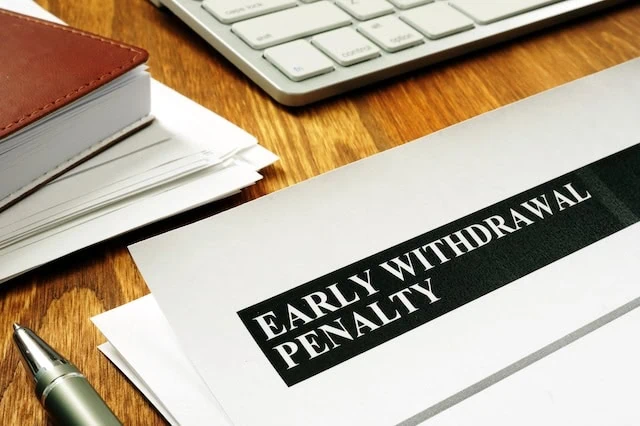If you try to withdraw early from just about any retirement plan, you’ll be slapped with a penalty—an incentive to leave your money alone and let it build toward retirement like you always intended.
But life doesn’t always go the way we expected. Sometimes we need that money well before the age at which we can start withdrawing funds penalty-free. Fortunately, while the rules around doing so are fairly strict, there are a few loopholes.
One of the most common penalties is a 10% fine levied against people who try to pull funds from qualified retirement plans like 401(k)s and individual retirement accounts (IRAs) before age 59½ (in addition to any taxes owed). And today, I’m going to talk about two rules designed to get around that penalty.
Read on as I discuss the Rule of 55 and Rule 72(t). I’ll explain how each rule works, how they differ, and which (if either) you should use in certain situations.
What Is the Rule of 55?

If you begin taking distributions from a 401(k), 403(b), Thrift Savings Plan, or a handful of other workplace retirement plans before age 59½, you generally will owe not just taxes on that distribution, but a 10% penalty as well.
However, the Rule of 55 allows you to start taking distributions from your 401(k) without the early withdrawal penalty if you have lost or left your job during or after the calendar year in which you turn 55 (or 50, if you’re a qualified public safety employee). Taxes will still apply, of course, just like they would if you were age 59½ or older—you’re just dodging the penalty.
Also, if you get a job later, you can continue to make penalty-free withdrawals (assuming the account hasn’t moved).
There are limitations. An individual can only start taking distributions from the retirement account connected to the employer they had when they left their job. Money that isn’t withdrawn must stay in that account—it can’t be rolled over to an individual retirement account (IRA). And employers aren’t required to allow for the Rule of 55.
You also can’t use the Rule of 55 if you retired at a younger age. For instance, if you leave a job at age 52 but only start taking distributions once you reach age 55, those withdrawals are still subject to the early withdrawal penalty.
Related: Plan for These 7 Hidden Retirement Costs
What Is Rule 72(t)?

Rule 72(t) isn’t a rule, per se, but rather a reference to Internal Revenue Code section 72(t), which outlines the 10% tax penalty imposed whenever a taxpayer receives funds from a qualified retirement plan. Among other things, it permits eligible individuals to make penalty-free withdrawals before age 59½ from the following types of retirement accounts:
- 401(k)
- 403(b)
- 457(b)
- Thrift Savings Plan (TSP)
- Individual retirement accounts (IRAs)
You can’t just take however much you want, whenever you want. Unless you meet certain IRS exemptions (more on this later), you must take at least five substantially equal periodic payments (SEPPs) or follow the payment schedule until age 59½, whichever is longer (exceptions for disability and death apply).
If you use Rule 72(t), you must choose one of three IRS-approved calculation methods for determining the size of your payments, all of which use one’s life expectancy as a factor:
- Required minimum distribution (RMD, usually results in lowest amount that can be withdrawn)
- Annuitization method
- Amortization method (usually results in highest amount that can be withdrawn)
Once you begin taking distributions, you cannot stop without paying the penalty. You also can’t change the SEPP amounts.
Related: 7 Retirement Account Withdrawal Mistakes to Avoid
How Are the Rule of 55 and Rule 72(t) Different?

The Rule of 55 and Rule 72(t) both allow eligible workers to take penalty-free withdrawals from eligible retirement accounts before age 59½.
But that’s largely where the similarity ends. A few noteworthy differences?
- Accounts: The Rule of 55 is limited to 401(k)s, 403(b)s, and Thrift Savings Plans. Rule 72(t) applies to these plans, but also 457s and IRAs.
- Age requirements: The Rule of 55 has a minimum age requirement of 55 (or 50 for qualified public safety employees). Rule 72(t) has no specified minimum age requirement.
- Withdrawal requirements: The Rule of 55 allows you to choose the size, frequency, and timing of distributions. Rule 72(t) has strict frequency and timing requirements, and the amount of distributions is mathematically determined by one of three methods that incorporate your life expectancy.
- Employment requirements: The Rule of 55, and how it operates, is based around a person losing or leaving their job. Rule 72(t) is not.
Related: What Does the Average 55- to 64-Year-Old Have in Retirement Accounts?
Which Rule Should I Use for Penalty-Free Withdrawals?

A lot of the decision-making when it comes to these rules is pretty automatic, just because the rules are so different and there are plenty of auto-disqualifications.
For instance, if you have an IRA or 457, you can’t even use the Rule of 55, so by default, you’d want to look at Rule 72(t).
If you haven’t left or been fired from your job, the Rule of 55 is out, too, unless you expect either thing to happen at some point in the future. If you retired several years ago, you can forget the Rule of 55, too. Same goes for your age—if you’re younger than 55 (or a qualified public safety employee who is younger than 50), the Rule of 55 waves bye-bye, too.
But let’s say you qualified for both—you’re 56 years old, you were just let go from your job, and you want to take penalty-free withdrawals from your 401(k). At that point, how you move forward is a matter of preference.
The Rule of 55 is much more flexible. You can choose how much money you want to withdraw (within the limits of your account balance, of course), when you want to withdraw those funds, and how many times you’ll withdraw that cash. However, Rule 72(t) would effectively only let you choose from one of three amounts (based on which of the three methods you use), and given that you would turn 59½ in less than five years, you would have to take distributions for at least five years.
The Rule of 55 lets you choose the amounts you withdraw. Comparatively, Rule 72(t) has strict rules for your withdrawal amounts as you have to follow one of the three IRS calculation methods.
Additionally, Rule 72(t) makes you take distributions until you turn 59½, or five years, whichever is later. When either rule is an option, you may want to opt for the Rule of 55 as the withdrawal amounts and frequency are flexible. You’re only limited by the account’s balance. There are no minimums or limits to how much can be withdrawn using the Rule of 55.
Of course, even if you qualify for penalty-free early distributions via either of these rules, it might be better to wait until you’re older to begin making withdrawals.
Related: How to Invest for (And in) Retirement: Strategies + Investment Options
Why Would I Avoid Taking Penalty-Free Early Withdrawals?

Just because you can take penalty-free early withdrawals from a retirement account doesn’t necessarily mean you should.
If you need money to cover your essential expenses and don’t have other options, penalty-free withdrawals are clearly better than paying penalties.
But if you can afford to leave money in your tax-advantaged accounts longer, you should. Any money pulled from these accounts deprives you of the compounded earnings they’ll generate over the years. So it might be wise to utilize other income sources first.
Consider consulting with a financial advisor about whether the Rule of 55 or Rule 72(t) makes sense for your current financial situation, or if you have better available alternatives.
Do you want to get serious about saving and planning for retirement? Sign up for Retire With Riley, Young and the Invested’s free retirement planning newsletter.
Are There Other Ways to Withdraw Early Without Penalty?

Yes, there are other options for making penalty-free withdrawals from certain retirement plans.
Yes, you may have other options for taking money from retirement accounts without penalties. To start, if you have a Roth retirement account, you can always withdraw contributions penalty-free because those contributions were already taxed.
For any type of IRA or qualified plan, such as a 401(k), there are exceptions to the early distribution penalty. Some of the exceptions have monetary limits. But if you qualify for an exception, it might be better to take a one-time withdrawal that way than to lock yourself into ongoing payments using Rule 72(t).
Another option may be a 401(k) loan. Like just about any loan, a 401(k) loan lets you borrow money from your retirement savings, and requires you to pay back that money (with interest) over time. But you should only consider this route if you are confident you can pay back the loan and interest in a timely manner. Not repaying the full loan and interest will result in any unpaid amounts to be treated as a distribution, which will trigger any applicable taxes and penalties. Some plans require the loan to be paid in full if you exit your job. Also, the interest rate for 401(k) loans is commonly a percentage point or two higher than the current prime rate.
Want to talk more about your financial goals or concerns? Our services include comprehensive financial planning, investment management, estate planning, taxes, and more! Schedule a call with Riley to discuss what you need, and what we can do for you.







![How Much to Save for Retirement by Age Group [Get on Track] 17 how much to save for retirement by age group](https://youngandtheinvested.com/wp-content/uploads/how-much-to-save-for-retirement-by-age-group-600x403.webp)

